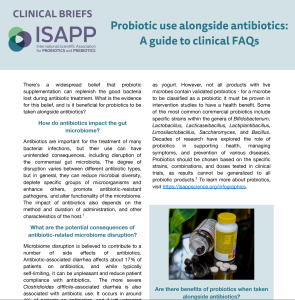Designing Probiotic Clinical Trials: What Placebo Should I Use?

By Daniel J. Merenstein, MD, Professor, Department of Family Medicine and Director of Research Programs, Georgetown University Medical Center, Washington DC
Specifying a placebo is one of the most important decisions for a clinical trialist. The first trial I led was a study giving Benadryl to kids to see if it helped them sleep. We spent hours working with our pharmacist on the placebo to make sure it had the same sweet cherry taste of the active drug, Benadryl. We didn’t want parents to be able to determine whether they were randomized to Benadryl or the placebo by comparing the study product to what they had at home. Do study subjects really do this? Yes. Early in my career I was helping an orthopedist who was putting pain pumps directly into a patient’s ankle post-surgery in order to see if it would decrease oral narcotic usage. One of our first patients pulled his pump out, tasted the medicine and called us late at night complaining he was in the saline (placebo) group.
When undertaking a study on probiotics, and specifically probiotic yogurts, we can debate for weeks about the best placebo. Our intervention is yogurt fortified with an additional probiotic. Therefore, our intervention yogurt contains both the starter lactic acid bacteria and the probiotic. So assuming we want both groups to get nutritionally equivalent yogurt that can be blinded our placebo options could be as follows. Note that in recent years, we have become more cognizant that dead microbes may not be biologically inactive.
| Placebo | Microbiological content of Placebo | Research question addressed |
| Yogurt | Live starter cultures, no probiotic | What is the contribution of probiotics to any health benefit? |
| Acidified yogurt | No live or dead microbes | What is the contribution of live probiotic + live starter cultures to any health benefit? |
| Heat treated yogurt | No live microbes, dead starter microbes | Beyond any contribution of dead starter cultures, what is the contribution of live probiotic + live starter cultures to the health benefit? |
| Heat treated probiotic yogurt | No live microbes, dead starter + dead probiotic microbes | Beyond any contribution of dead probiotics + dead starter cultures, what is the contribution of live probiotic + live starter cultures to the health benefit? |
| Probiotic yogurt using a different probiotic | Live starter cultures, live probiotic different from the probiotic in the intervention | What is the contribution of the intervention probiotic to any health benefit compared to the control probiotic? |
We chose regular yogurt (the first option above) and now about eight papers later, I would say that about 50% of reviewers question our choice.
There are many reasons the placebo needs to be well considered, including the specific research question under consideration. But an important one is clinical equipoise, “a state of genuine uncertainty on the part of the clinical investigator regarding the comparative therapeutic merits of each arm in a trial”, as defined Freedman 1987. Thus, for example in a study of a new hypertension drug, one cannot use a placebo that has no chance of lowering a patient’s blood pressure as a comparator as that is ethically indefensible. Instead, a well proven hypertension drug will be studied versus the new experimental drug.
For most of my career the goal in my studies was to pick a placebo that was as inactive as possible that still smelled, looked and tasted like my active intervention. However, the times are changing. When I started working there were fewer than 200 randomized controlled clinical probiotic trials retrievable from PubMed; today the number is over 2,300. Well that means we have gone beyond merely recognizing the value of probiotics in different indications, to detailed comparisons of different probiotic and non-probiotic interventions, so one has to consider how inactive their placebo is for probiotic intervention trials.
In 2020 the American Gastrointestinal Association came out with recommendations and guidelines after they conducted a thorough review of probiotic evidence. (See ISAPP blog ISAPP take-home points from American Gastroenterological Association guidelines on probiotic use for gastrointestinal disorders.) For three indications, they recommended using select probiotics over no or other probiotics, in populations of preterm low birthweight infants, patients receiving antibiotics, and patients with pouchitis. So what does this mean for trials evaluating one of these indications? It means that the placebo should be an active control, a probiotic versus probiotic trial.
Today if I’m asked what placebo should be used, my first question is what indication are you studying? If you are studying infant colic or preterm low birthweight infants, I think you need an active control, such as another probiotic. (Colleagues and I suggested this for probiotic studies on necrotizing enterocolitis in 2013.) If you are studying anxiety, then an inert placebo makes the most sense since insufficient evidence exists for any probiotic for this endpoint as yet. In the case of antibiotic associated diarrhea, it will be a much longer discussion as the data are not clear, but it would be reasonable for an IRB to argue that your placebo should be another probiotic. It is not ethical to deny a placebo group an effective intervention if one is available.
So in the last 15 years of my career the answer to what placebo should I use has greatly changed. As probiotic research has advanced, so has the evidence base for usage. As we proceed with research we now need to consider conducting our clinical trials differently. This is just another example of how probiotic evidence has matured over a relatively short period of time.



